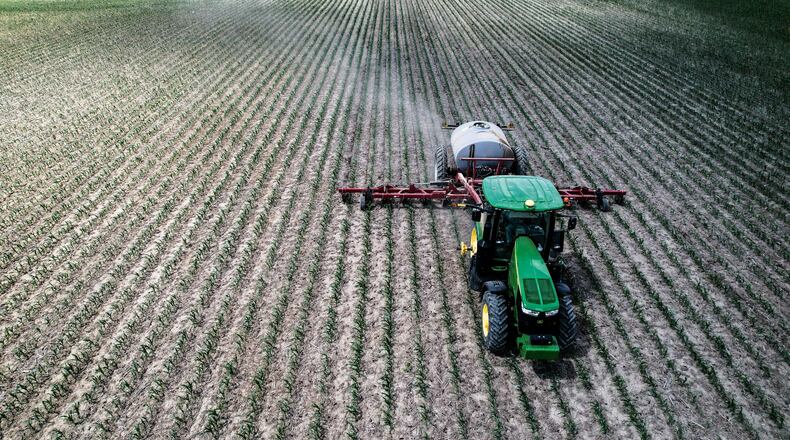“We could use some rain. Most farmers have their crops in the ground, but because we haven’t had rain in several weeks I see some farmers replanting soybeans,” said Greg McGlinch, a Darke County farmer.
McGlinch said the last rain he had on his farm near Versailles was an inch on May. 19.
“There’s still some moisture in the ground and the corn looks pretty good right now, but we’re going to need some rain in the next few weeks or we’re going to have problems,” said McGlinch, who added his corn was 3 to 8 inches high last week.
Credit: Bill Lackey
Credit: Bill Lackey
May ended with 1.89 inches of precipitation, which is less than half of the normal amount. The Dayton area last saw recorded precipitation on May 20 and hasn’t had more than an inch of rain in 61 days.
Total precipitation this year through May of 17.23 inches is the lowest since 2015.
McGlinch said the weather has been perfect for the hay crop.
According to the U.S. Department of Agriculture Ohio Crop Weather Report issued Tuesday, May 30, corn and soybean planting by Ohio farmers reached 89% to 87%, respectively. In 2022, the Ohio soybean and corn crop was around 60% planted in this same week.
“We’ve made decent progress,” said Ty Higgins, Ohio Farm Bureau spokesman. “Planters are in the fields. The equipment is bigger which makes planting faster. Technology is certainly our friend.”
Higgins said the philosophy of planting has also changed as farmers are now planting soybeans first because they are more resilient to colder and wet soil. After the soybeans are in, corn is being planted.
Farm income down
In its Feb. 7 report, the U.S. Department of Agriculture, Economic Research Service said farm sector income is forecast to fall this year following two years of strong growth.
Net farm income, a broad measure of profits, is forecast to decrease by $25.9 billion or 15.9% from 2022 to $136.9 billion in calendar year 2023. This expected decrease follows an annual increase of $46.5 billion or 49.2% in 2021 and a forecast increase of $21.9 billion or 15.5% in 2022, according to the report.
Net cash farm income is forecast to decrease by $39.4 billion or 20.7% from 2022 to $150.6 billion in 2023, after an annual increase of $32.7 billion or 28% in 2021 and a forecast increase of $40.4 billion or 27% in 2022.
In inflation-adjusted dollars, net farm income is forecast to decrease by $30.5 billion or 18.2% in 2023 and net cash farm income is forecast to decrease by $44.7 billion or 22.9% compared with the previous year. If realized, both income measures would remain above their 2020 level and 2002-2021 average in inflation-adjusted dollars, according to the report.
Nationally, corn receipts are forecast to fall by $4.1 billion or 4.5%, as higher quantities sold are not expected to offset lower expected prices, according to the report. Soybean receipts are expected to decline $5.2 billion or 8.1%, mainly due to lower forecasted prices. Expected growth in quantities sold should result in a gain in wheat receipts; they are forecast up $0.6 billion or 4% higher in 2022.
The report also forecast total production expenses, including those associated with operator dwellings, are forecast to increase by $18.2 billion or 4.1% in 2023 to $459.5 billion this year. Interest expenses and livestock/poultry purchases are expected to increase in 2023 while spending on feed and fuels/oils is expected to decline relative to 2022.
‘Supply and demand’
As of May 16, the USDA weekly National Agricultural Summary said producers had planted 65% of the nation’s corn crop, 20 percentage points ahead of last year and 6 points ahead of the 5-year average. Thirty percent of the nation’s corn acreage had emerged by May 14, 17 points ahead of the previous year and 5 points ahead of average.
That same USDA report said 49% of the nation’s soybean acreage was planted by May 14, 22 percentage points ahead of last year and 13 points ahead of the 5-year average. It also said 20% of the nation’s soybean acreage had emerged by May 14, 12 percentage points ahead of last year and 9 points ahead of average.
“Fertilizer prices are down and supply chain issues have eased and are not as bad as before,” said Craig Corry, who farms about 500 acres in Greene County. “We try to look for buying opportunities to lock in bulk prices for food because of the fuel fluctuations.”
Corry said farm income is based on grain prices.
“If we don’t have any issues that lower crop yields or weather issues and we all have a good crop, supply and demand could lower prices,” he said.
Corry said inflation and interest rates will have an impact on farm income as it becomes more expensive to borrow money for an operations loan and inputs such as seed and fertilizer are costing more.
“That affects the bottom line every year and requires farmers to sharpen their pencils,” Corry said.
Brian Harbage operates a mid-sized farm in Clark County where he grows hay, corn, wheat, soybeans and raises cattle.
“We were way behind last year. I’m not sure if we planted yet this time last year,” Harbage said in mid-May.
Harbage said the price of input costs and fuel are easing up, but that it’s still tough to get parts. In addition, interest rates for operation loans and lines of credit will increase costs for people wanting to buy more land and/or make capital investments for machinery.
“If we have lower pricing for commodities, the higher interest rates will affect us,” he said.
Another area of concern is global stability as China has cancelled some soybean orders which means fewer exports, Harbage said.
Credit: Bill Lackey
Credit: Bill Lackey
McGlinch said input costs have levelled off this year but has not heard much on crop futures.
“It’s hard to say with the economic and global issues,” he said. “Crop prices are holding steady but are trending down.”
‘So many variables’
A fifth-generation farmer with his father, Gary, McGlinch’s family has been farming for more than 100 years. They farm corn, soybeans, wheat, cereal rye, oats, clover, and raise pasture chickens on about 450 acres near Versailles. He said they have been diversifying the farm by trying different crops and selling seed on the side.
He said last year was “a fairly decent year” and added, “once we get it planted, we let Mother Nature take over.”
Dean Thompson, another Darke County farmer, retired last year after his brother retired a few years ago. He said he’s helping his two grandsons who took over the 1,400-acre family farm. He said they did well with the prices and yields with their soybean crop last year.
Thompson said they expected to finish their planting in the next week or so, depending on the weather.
Thompson said 2023 has a good chance of declining income based on global events, adding that affects local prices, not U.S. news.
He also said the costs of fertilizer and other chemical inputs have gone up and price of gas and diesel have fluctuated.
“A lot of guys got out early to plant corn and beans in April with the warm weather before the cold and rain,” he said. “We worked our ground. It’s a hard thing to predict because there are so many variables in the farm game. Who knows what tomorrow will bring. It’s been that way since 1962 when I started farming.”
Staff Writer Rich Gillette contributed to this report.
About the Author






